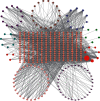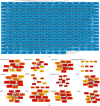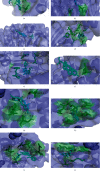Network Pharmacology and Molecular Docking Analysis of the Mechanism Underlying Yikunyin's Therapeutic Effect on Menopausal Syndrome
- PMID: 35707470
- PMCID: PMC9192326
- DOI: 10.1155/2022/7302419
Network Pharmacology and Molecular Docking Analysis of the Mechanism Underlying Yikunyin's Therapeutic Effect on Menopausal Syndrome
Abstract
Objective: Yikunyin is an empirical prescription that exhibits good efficacy in the clinical treatment of menopausal syndrome; however, its underlying mechanism remains unclear. This study investigates the mechanism implicated in the therapeutic effect of Yikunyin by identifying its hub genes, central pathways, and key active ingredients.
Method: The active ingredients and targets of Yikunyin were obtained from the Traditional Chinese Medicine Systems Pharmacology database, whereas the targets related to menopausal syndrome were obtained from GeneCards, PharmGKB, Therapeutic Target Database (TTD), and Comparative Toxicogenomics Database (CTD). To reveal the pharmacological mechanism, the component-target and the intersecting protein-protein interaction (PPI) networks were constructed, and Gene Ontology (GO) and Kyoto Encyclopedia of Genes and Genomes (KEGG) analyses were performed. Finally, molecular docking was carried out to assess the strength of binding between the key active ingredients and key targets.
Results: A total of 418 targets and 121 active ingredients were identified in Yikunyin. The intersection of Yikunyin's 418 targets with the 2822 targets related to menopausal syndrome shows that there are 247 common targets that can be considered potential targets of Yikunyin in the treatment of menopausal syndrome. The topology analysis of the constructed PPI network conducted using the Cytoscape software shows that there are 15 hub genes implicated in the therapeutic effect of Yikunyin: AKT1, PRKCA, TLR9, CXCL10, PRKCD, PARP1, ABCB1, TP53, CAV1, MAPK8, PPARA, GRB2, EGFR, IL-6, and JAK2. Moreover, the key active components acting on these genes are paeoniflorin, luteolin, quercetin, beta-sitosterol, and kaempferol. GO and KEGG analyses indicate that Yikunyin can treat menopausal syndrome by regulating cellular response to chemical stress (GO:0062197), cellular response to oxidative stress (GO:0034599), phosphatase binding (GO:0019902), cytokine receptor binding (GO:0005126), PI3K-Akt signaling (hsa04151), lipid and atherosclerosis (hsa05417), and hepatitis B (hsa05161). Finally, the results of molecular docking suggest that the key active ingredients and key targets can bind well, with binding energies of less than -5 kJ/mol.
Conclusion: The research conducted herein reveals that Yikunyin treats menopausal syndrome by targeting AKT1 and IL-6 and by regulating the PI3K-Akt signaling pathway. Moreover, it provides a new idea for understanding the therapeutic effects of traditional Chinese medicines.
Copyright © 2022 Xin Tan et al.
Conflict of interest statement
The authors declare that they have no known conflicts of interests or personal relationships that could have appeared to influence the work reported in this study.
Figures







References
LinkOut - more resources
Full Text Sources
Research Materials
Miscellaneous

